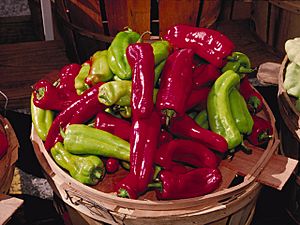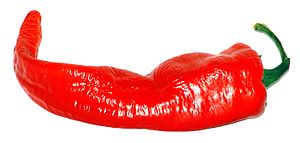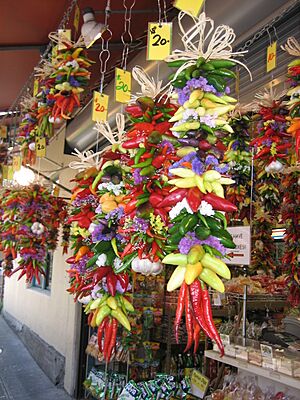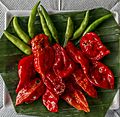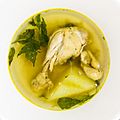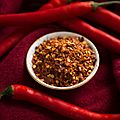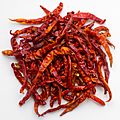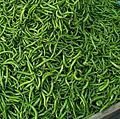Chili pepper facts for kids
The chili pepper, also called "chilli" or just "chili", is the fruit of plants from the Capsicum family. These plants are part of the nightshade family. Even though many people think of chilis as a vegetable, they are actually used more like a spice in cooking. From a plant science point of view, the chili plant is considered a berry shrub!
Chili peppers first grew in the Americas. Now, you can find them growing all over the world. People use them widely as spices or vegetables in many different types of food. They are also sometimes used as medicine.
Contents
History of Chili Peppers
Chili peppers have been a part of what people eat in the Americas for a very long time. They were used at least 7,500 years ago, and maybe even earlier! Scientists who study old things have found proof in Ecuador. This shows that chili peppers were already being grown by people more than 6,000 years ago. They were one of the first crops grown in the Americas.
Types of Chili Peppers
There are many different kinds of chili peppers. They are often grouped into three main types: bell peppers, sweet peppers, and hot peppers. Most popular peppers fit into one of these groups or are a mix of them.
Here are some of the most common types of chili peppers:
- Capsicum annuum: This group includes many well-known peppers. Examples are bell peppers, paprika, cayenne, jalapeños, and chiltepin.
- Capsicum frutescens: This group includes the tabasco peppers.
- Capsicum chinense: This group has some of the hottest peppers. These include the naga, habanero, and Scotch bonnet.
- Capsicum pubescens: This group includes the rocoto peppers from South America.
- Capsicum baccatum: This group includes the aji peppers, also from South America.
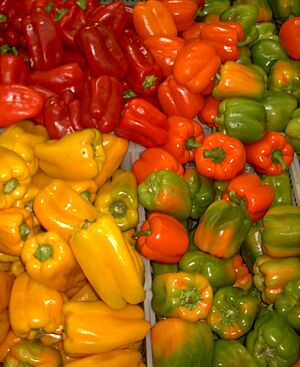
It's important to know that chili peppers are not related to the plant that Black pepper comes from. They are from completely different plant families.
Why Chilies Are Hot
The reason chili peppers feel hot when you eat them is because of special chemicals. These chemicals are called capsaicinoids. The main one is capsaicin. Capsaicin is also the main ingredient in pepper spray.
When you eat something with capsaicinoids, they connect with pain sensors in your mouth and throat. These sensors usually feel heat. When the capsaicinoids activate them, they send a message to your brain. The message tells your brain that you've eaten something hot. Your brain then reacts to this burning feeling. It might make your heart beat faster, make you sweat more, and release natural pain-relieving chemicals called endorphins.
How Chilies Are Used in Cooking
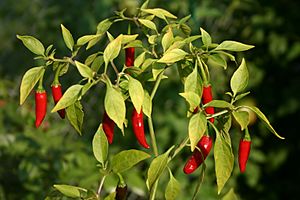
Chili peppers have been used in Mexican cuisine for a long time. They are also a big part of Tex-Mex cuisine. Even though Europeans brought chilies to Asia, they are now very popular there. You can find them in Korean, Indian, Indonesian, Szechuan, and Thai cooking. Their popularity means they are now used in many types of food all over the world.
The Chili Fruit
You can eat the chili fruit raw or cooked. Its fiery hot flavor is strongest at the top of the pod. The part of the stem where it connects to the pod has glands that make the capsaicin. This capsaicin then flows down through the pod. The white pith, which is the spongy part around the seeds, has the most capsaicin. If you want to make a chili less hot, you can remove the seeds and these inner white membranes.
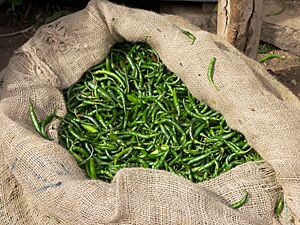
Chili is often sold around the world as a spice in a dried and powdered form. In the United States, chili powder is often made from a Mexican chili called chile ancho. Sometimes, a small amount of cayenne is added for more heat. In the Southwest United States, a mix of dried ground chili peppers, cumin, garlic, and oregano is often called chili powder. Chipotles are actually red (ripe) jalapeños that have been dried and smoked.
Chili peppers are also used to make many different sauces. These are known as hot sauce, chili sauce, or pepper sauce. There are countless recipes for these sauces.
Chilies for Decoration
Some types of chili peppers are grown just for how pretty they look. They are called "ornamental peppers." Some of these are too hot to eat, or they just don't taste very good. Others can be used for both decoration and food. These decorative peppers often have unusual shapes or colors.
Why Chilies Are Popular
Chili peppers are very popular in food around the world. They are full of vitamin C. Many people also believe they have good effects on your health.
Images for kids
-
Sambal is the name for chili paste in Indonesian, Malaysian and Singaporean cuisine
-
Thai curry pastes contain large amounts of chilies
-
The habanero pepper
-
Removing veins and seeds from dried chilies in San Pedro Atocpan
-
Dried Thai bird's eye chilies
-
Guntur chilli drying in the sun, Andhra Pradesh, India
-
New Mexico chiles dried on the plant in Mesilla, New Mexico
See also
 In Spanish: Chile (pimiento) para niños
In Spanish: Chile (pimiento) para niños


